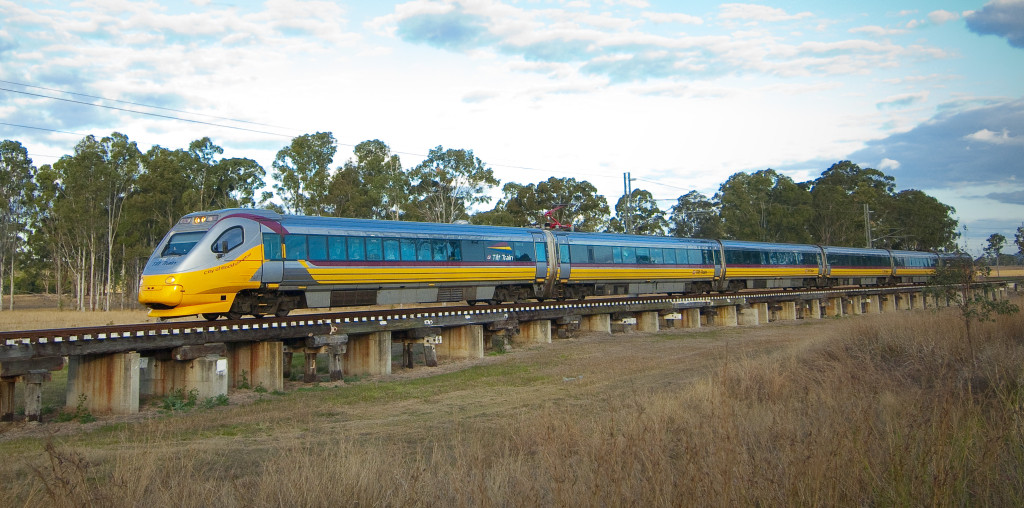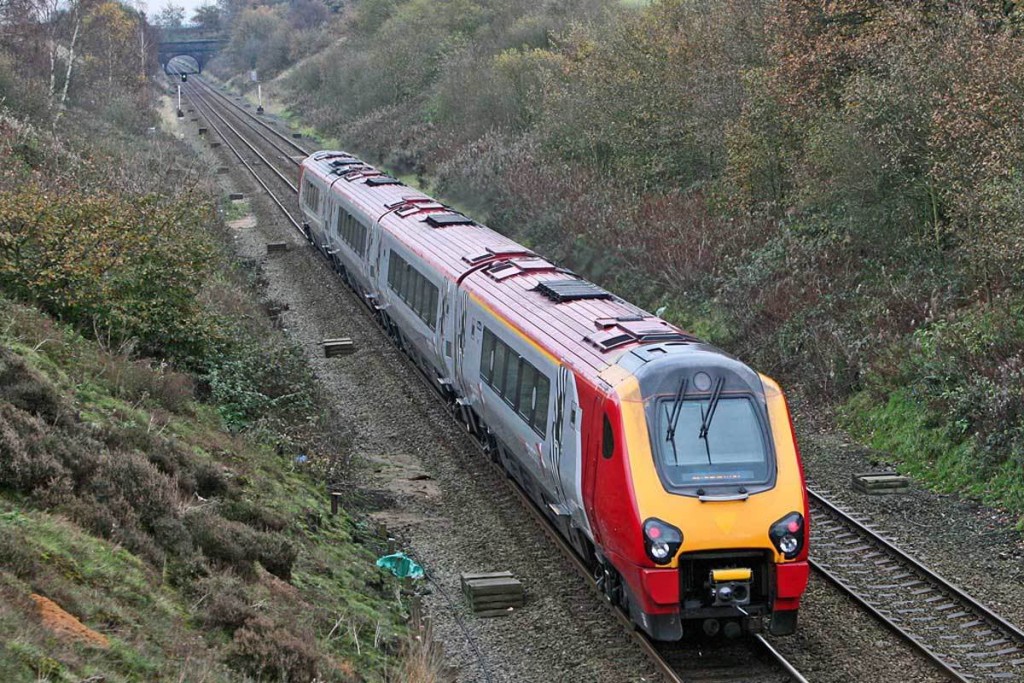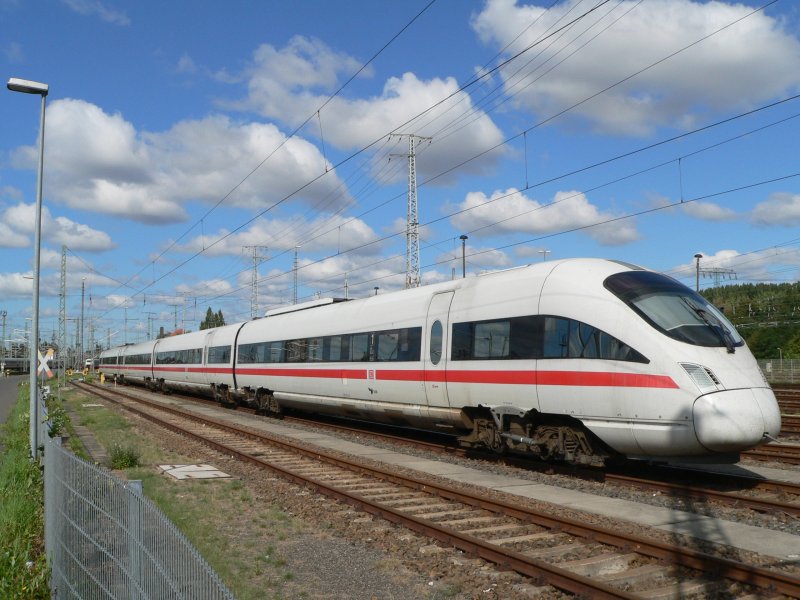Although it is probable that rollingstock will be constructed specifically for any new HSR-capable railroads, it is far cheaper to develop a variant of an existing class of railcar than an entirely new design. This post will look at some of the existing technology that might fit our needs.
The basic requirements for rollingstock in the Hot Rails plan are as follows:
- Capable of 200km/h
- Self-powered
- Tilting
There are numerous trains either in use or under development that fit this bill. We will look at a few of them.
Transwa WDA/B/C-class

Transwa Prospector service to Kalgoorlie. Image: Nachoman
The trains used on the Western Australian AvonLink and Prospector services have a top speed of 200km/h, although track conditions currently restrict their operating speed to 160km/h. They were built by Victorian-based UGL Rail between 2000 and 2004. Although the trains do not employ tilting technology, it may be possible to develop a tilting variant.
Queensland Tilt-Train

QR Tilt-Train on the Cairns line. Image: Queensland Rail
Australia has another train which comes close to fulfilling the Hot Rails specs: the diesel version of Queensland Rail’s “Tilt-Train” which runs the Brisbane-Cairns route. Its top speed is 160km/h, but the electric version holds the Australian speed record of 210km/h, which it set in 1999.
The trains were expensive; the original 6-car electric versions cost $60m each in 1998, and a recent plan to add a new 14-car tilt-train to the Cairns route and upgrade the two existing trains from 9 to 14 cars was costed at $195 million (2011 prices). This comes to a bit over $8m per car; we can assume a standard 8-car trainset would therefore cost about $65m.
It is almost certainly possible to upgrade the power of the engine to enable 200km/h capability; several DMUs exist throughout the world that can achieve this speed. Indeed, the Transwa Prospector is one of them.
Virgin Trains “Super Voyager”

BR Class 220 (non-tilt version) passing through Manchester. Photo: PTA Transit Authority
The British Rail Class 221 is utilised by Virgin Trains under the name “Super Voyager”. It is a tilting, DMU train capable of 200km/h. 44 trainsets were built by Bombardier between 2000 and 2001, giving this train an extensive track record. There is precedent of British-derived trains being built in Australia, with the 1980s-era XPT (a derivative of the British HST) still being used on country NSW routes. A similar arrangement could work with the BR-220.
Similar high-speed DMUs such as the Class-180 are also available, but these are not tilting.
Intercity Express TD

German ICE-TD high-speed train in Berlin. Image: Rail-pictures.com
The Deutsche Bahn VT-605, commonly known as the ICE-TD, is the one of the only operational high-speed tilting DMU on the European continent. 20 trainsets were built from 1996-2001, but its operational history has been plagued by technical problems – this has been blamed on attempting to introduce too many innovative features on a new train (the tilting mechanism itself was relatively problem-free). Since 2007 they have been used on the Berlin-Hamburg-Copenhagen route due to delays commissioning the new Danish IC4 DMU.
The styling of the ICE trains is particularly sleek and modern, despite being the oldest of the trains considered here.
Bombardier JetTrain

JetTrain test unit in Quebec, 2003. Image: Pierre Gillard
The top speed attainable with DMUs appears to be about 200km/h. Perhaps the most exciting possibility for Hot Rails is a completely new system – the turbine-electric concept, which promises true HSR-capability with speeds up to 250km/h or greater.
In the early 2000s, Bombardier developed a prototype turbine-electric tilting train for the US rail network. Instead of a heavy diesel engine, a lightweight gas-turbine jet engine is used, giving the vehicle a much higher power-to-weight ratio. Because jet engines are highly inefficient at low power, a much smaller diesel engine is used for maneuvering in switchyards or stations, and for head-end power.
Styled in the same vein as the existing Amtrak Acela-Express rollingstock, it aimed to introduce HSR to the American market without the need for entirely new track alignments – a strategy remarkably similar to that advocated by Hot Rails. The system was tested at sites in Colorado, Florida and Quebec, however the proposal did not progress beyond initial engineering assessments. There have been suggestions that the JetTrain would be appropriate for HSR systems in the UK, Mexico and even Australia, but no serious engineering studies as yet.
According to contemporary news reports, a set of 20 trains would have cost $800m in 2002 ($US40m per train). This is about $90-100m in 2014 Australian dollars (depending on your assumed exchange rate – the Aussie dollar was very low in the early 2000s). JetTrain is no longer promoted by Bombardier, however it is likely that the blueprints could be dusted off if a customer were found with a demand for such a product. However it is likely that teething problems could be expected with an all-new system such as this.
Conclusion
There are numerous existing train technologies that could be used as a basis for a HotRails trainset. The plausible price for an eight-car tilting trainset seems to be somewhere between $60 and $100m, although the high end of this estimate comes from a US estimate during a period when the Australian dollar was very weak. The AECOM13 study (section 4.1.1) assumed the cost of a 200m trainset to be $45m, and a 300m trainset to be $70m. These costs seem on the low side (especially given the 350km/h design speed), but it is expected that a cost premium would be paid for both non-electric and tilting technology.
Given the generally very conservative price estimates in AECOM13, we will take the low end of our estimates of $60m for an 8-car trainset with 200km/h capability.



